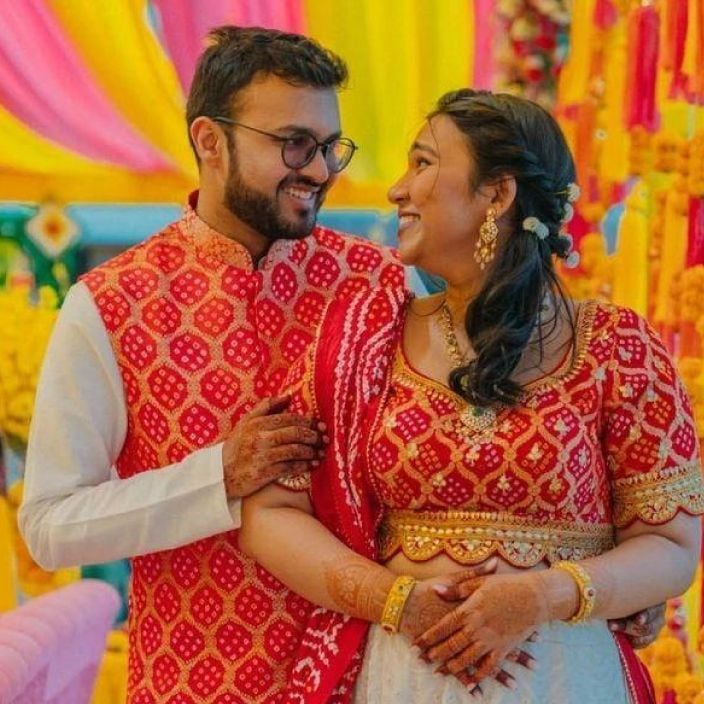For best prices and early deliveries, WhatsApp us at. 918488070070
Chhattisgarh
Weddings in Chhattisgarh are an explosion of colours, traditions, and rituals; a vibrant blend of ancient customs that reflect the rich cultural heritage of this central Indian state. From the elaborate pre-wedding rituals to the festive feasts, weddings in Chhattisgarh are truly a sight to behold.
Tracing the Traditions
Each region of Chhattisgarh brings its unique twist to wedding traditions, with rituals passed down through generations. Though the sequence of events may vary slightly depending on local customs, many ceremonies are deeply rooted in the state's culture.
Like many other Indian states, it typically begins with the Ganesh Pooja. Following this is the Saga-Neti Talk, a customary discussion between the elders of both families to finalize wedding details. The Tilak or sagai ceremony marks the formal engagement between the bride and groom's families. In this ritual, the groom’s family visits the bride’s home, and the bride's father applies tilak on the groom’s forehead. In addition, the Haldi ceremony is one of the most fun-filled and essential pre-wedding rituals, where a turmeric paste is applied to both the bride and groom by their family members and friends. Another key moment is Barish Ke Kritye, a ritual specific to certain regions in Chhattisgarh, performed to seek the blessings of nature for a harmonious union.
Even the Mehendi ceremony, which involves the application of intricate patterns of henna applied to the bride's hands and feet, holds significant cultural importance.
Then comes the wedding day itself, the Baraat, a lively procession led by the groom and his family, announces their arrival at the wedding venue, comprising Pheras and Sindhoor, sealing the deal. After the wedding is done, the bride’s Bidai (farewell) is an emotional moment as she leaves her parental home to begin a new life. the bride participates in Mooh Dikhai, a post-wedding ritual which is a symbolic "first look" of the bride by the groom’s family. The veil that covers the bride’s face is lifted, and the family presents her with gifts and blessings.
Wedding Attire
A Chhattisgarh bride typically wears a saree, usually in vibrant colours like red, maroon, or gold. The saree is often intricately embroidered with traditional designs, adding to its elegance. Brides also don a lehenga in some regions, but the saree remains the most iconic piece of clothing. In some regions of Chhattisgarh, brides wear the Kosa silk saree, a handwoven masterpiece native to the state. A Dupatta, draped gracefully over the head or shoulders, complements the saree, adding an extra layer of modesty and style.
The bride's jewellery is equally exquisite, with pieces that include mangalsutra, Kamarbandh (waistbelt), bichiya, nath, chooda, and payal. Brides often wear a Maangtikka that sits elegantly on her forehead, baajubandh (armlets) and mathapatti, adding to their regal look.
The groom, on the other hand, typically wears a dhoti-kurta or sherwani, along with a Pagri (turban), and a pair of Mojari, depending on the local customs. His outfit is usually in shades of white, gold, or cream.
Traditional Cuisine
No wedding in Chhattisgarh is complete without the mouth-watering feast that accompanies the celebration. Food plays a pivotal role in the wedding festivities, with an emphasis on traditional flavours that have been part of the state’s culinary heritage for centuries.
Chana Samosa is a favourite snack at pre-wedding functions, paired with tangy tamarind chutney. For a healthier bite, Bafauri – made from gram flour and spiced with herbs – offers a savoury treat. Muthiya, a light steamed dumpling, showcases the simplicity of local cuisine, while the rustic Aamat, a vegetable dish cooked in bamboo shoots, adds earthy flavours to the feast.
Main courses often feature Faraa, a lentil-stuffed dumpling, and the celebrations wrap up with Dehrori, a sweet, syrup-soaked dessert made from fermented rice batter.
Apart from these signature dishes, a typical wedding menu in Chhattisgarh includes rice, lentils, and an assortment of vegetables, all cooked with locally sourced ingredients.
Cultural Decor
The decor at a Chhattisgarh wedding is a sight to behold, often rooted in traditional aesthetics with a modern twist. Most weddings take place in the open air, under a beautifully decorated mandap, where the main wedding rituals occur.
The mandap is usually adorned with fresh flowers, often marigolds and jasmine, which hold symbolic meanings of purity, happiness, and divine blessings.
In many parts of rural Chhattisgarh, the decor is inspired by the natural surroundings, with banana leaves, mango leaves, and earthen pots playing a central role. Torans are also hung at the entrance.




